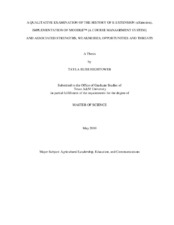| dc.contributor.advisor | Murphrey, Theresa P. | |
| dc.creator | Hightower, Tayla Elise | |
| dc.date.accessioned | 2011-08-08T22:47:53Z | |
| dc.date.accessioned | 2011-08-09T01:29:04Z | |
| dc.date.available | 2011-08-08T22:47:53Z | |
| dc.date.available | 2011-08-09T01:29:04Z | |
| dc.date.created | 2010-05 | |
| dc.date.issued | 2011-08-08 | |
| dc.date.submitted | May 2010 | |
| dc.identifier.uri | https://hdl.handle.net/1969.1/ETD-TAMU-2010-05-7833 | |
| dc.description.abstract | According to research by Tennessen, PonTell, Romine and Motheral (1997), the Extension System has been educating the nation for over 96 years, and the idea of using technology as a medium for education has been in the minds of Extension educators for over 40 years. The National E-Extension (eXtension) Initiative is being adopted at a rapid pace, and the history of this impact requires documentation in order to assist others in similar adoption and diffusion processes. The purpose of this historical study was to describe how and why eXtension was established and the implementation of Moodle as a Course Management System (CMS) within eXtension. The researcher was able to determine that the eXtension system is becoming an accepted form of education for Extension. However, barriers to adoption do exist. The study revealed that online education is becoming part of Extension through eXtension, but as awareness grows and develops the eXtension system must do the same.
Technology is offering new ways to reach clientele, and as such, Extension continues to strive to take advantage of these technologies. This study consisted of two parts. The first part sought to document the history of eXtension and the implementation of Moodle as a Course Management System (CMS) in Extension. The second part sought to identify the strengths, weaknesses, opportunities and threats (SWOT) related to the use of Moodle as a Course Management System within eXtension. Interviews were conducted with five individuals knowledgeable of the history of eXtension and the implementation of Moodle concerning their experience. For the second part, interviews were conducted with nine individuals currently serving as instructors within one or both eXtension Moodle websites. The researcher was able to document the history of eXtension and Moodle and determine 11 emerging themes within the predetermined areas of strengths, weaknesses, opportunities and threats. Findings revealed that those involved in using Moodle within Extension have knowledge of the innovation, have formed an attitude toward the innovation, and have decided to adopt or reject the innovation based on the stages of Rogers' innovation-decision process. Completion of the implementation of the innovation and confirmation of the decision stage of the process will be most effectively completed through the work of eXtension at the national level. | en |
| dc.format.mimetype | application/pdf | |
| dc.language.iso | en_US | |
| dc.subject | eXtension | en |
| dc.subject | eLearning | en |
| dc.subject | Texas AgriLife Extension | en |
| dc.subject | Moodle | en |
| dc.subject | online learning | en |
| dc.subject | Cooperative Extension | en |
| dc.subject | SWOT analysis | en |
| dc.subject | Course Management System | en |
| dc.title | A Qualitative Examination of the History of E-Extension (eXtension), Implementation of Moodle (A Course Management System) and Associated Strengths, Weaknesses, Opportunities and Threats | en |
| dc.type | Thesis | en |
| thesis.degree.department | Agricultural Leadership, Education, and Communications | en |
| thesis.degree.discipline | Agricultural Leadership, Education, and Communications | en |
| thesis.degree.grantor | Texas A&M University | en |
| thesis.degree.name | Master of Science | en |
| thesis.degree.level | Masters | en |
| dc.contributor.committeeMember | Dooley, Kim E. | |
| dc.contributor.committeeMember | Faries, Floron J. | |
| dc.type.genre | thesis | en |
| dc.type.material | text | en |


